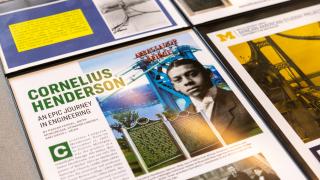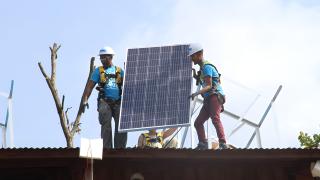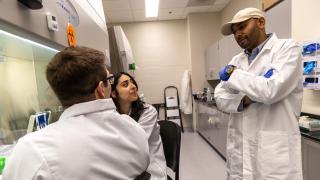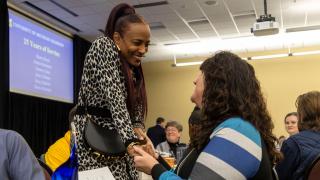
This article was originally published on May 10, 2021.
Ali Beydoun, Sara Al-Delahmawi, Louay Masri Elyafaoui, Lara Harp and Ali Rammouni all met in-person exactly once during the semester they were working on their Senior Design project. It was in the lobby of The Union, and the five of them got together for a few hours to assemble the prototype rehabilitation device for stroke patients that they’d been working on for months. Because of the need for social distancing, they’d each worked separately on a component or two: Al-Delahmawi sewed the custom sleeve to fit the patient’s arm and hold the sensors; Rammouni, Beydoun and Elyafaoui developed the housing, coding and other essential tech; and Harp designed the patient testing protocol. Now, they had one shot to put it all together and see if it actually worked. “I think I broke a sweat when one of the sensors didn’t work for a second,” Rammouni says, laughing. “And then we almost dropped the housing when we tried to fit the device onto Ali Beydoun’s arm. But other than that and needing to tweak a few settings, everything worked great.”
Everyone on the team agreed that the pressure of knowing they’d have limited face time probably sharpened their planning, and all things considered, it’s been a pretty smooth Senior Design experience. Their savvy use of technology has been a big reason why. The group used shared folders to keep all their documents organized, and they had twice-a-week Zoom meetings to make sure they were staying on schedule. They also used a WhatsApp chat group pretty constantly, especially to make sure they didn’t lose track of the good ideas that came at random times of day. Beydoun says the mostly remote format made it way easier on him, in particular, because he was in Ohio all semester doing a co-op. And the few situations that did require in-person work — like when Al-Delahmawi and Rammouni fine-tuned the fit of the sleeve — they did without convening the entire group to minimize risk. Honestly, hearing them talk about it, they sound more like a well-organized start-up crew than a bunch of college seniors coping during a pandemic.
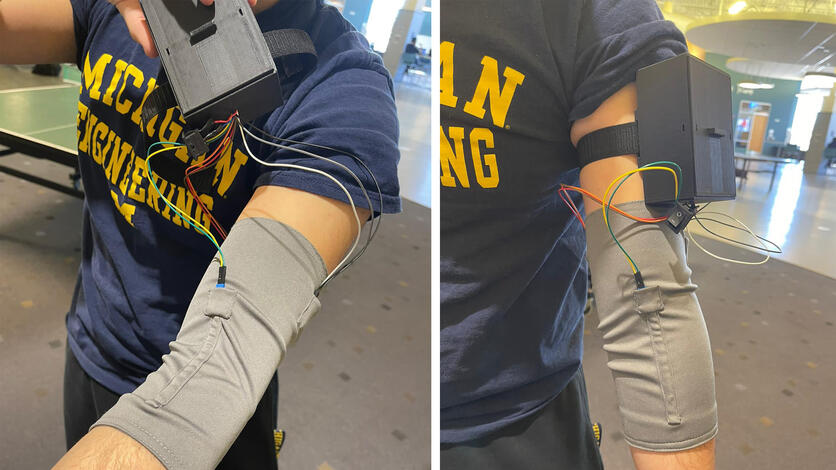
Mechanical Engineering Professor and Bioengineering Program Director Alan Argento, who advised the group and also coordinates the Senior Design program, agrees that the quality of the work hasn’t lagged in this more remote format. However, the emphasis has shifted a bit, and he says that’s partly for the better. Specifically, the nature of the more remote format naturally put the focus back on the design part of Senior Design. “I think over the years, we’ve gradually seen some teams spend more time on the build part, to the point where some of these projects are really more build projects than design projects,” Argento says. “But this isn’t a shop class project. There are a few reasons for the course, but the core purpose is for the students to demonstrate that they can design something from scratch using the theories they’ve learned over the prior four years. There’s a hands-on component, and most teams this year still did build something, though the remote format did mean we couldn’t conduct larger-scale projects with substantial, collaborative builds. But with the constraints of social distancing, you could tell they put a lot more focus on their designs, which is one of the reasons I think the projects were of such high quality.”
Argento noticed some other silver linings. In lieu of the build phase, which was optional this year, some teams made better use of simulations, which Argento says were significantly more advanced this year. And they also discovered some new ways to incorporate 3D-printing into the design process. “You can’t learn everything from designing on paper or in software,” he explains. “There are times when you just have to have a physical object and see how something works. So we’ve been using 3D-printing not to print real parts, but to create gradually better versions of things so they can do that trial-and-error learning.” For some teams, in fact, Argento says their build phase consisted of a series of 3D prints that demonstrated a process leading to an improved final design.
Going forward, Argento says he and the other faculty advisors plan to incorporate many of these ideas into Senior Design, even once the program can move back to its more familiar in-person format. And while some students were a little disappointed by the lack of hands-on time, he says it’s entirely possible these job-seeking seniors will reap some immediate benefits. As they head out into a workforce that promises to be more remote than ever, they all can now feature work-from-anywhere expertise prominently on their resumes.
###
Story by Lou Blouin

